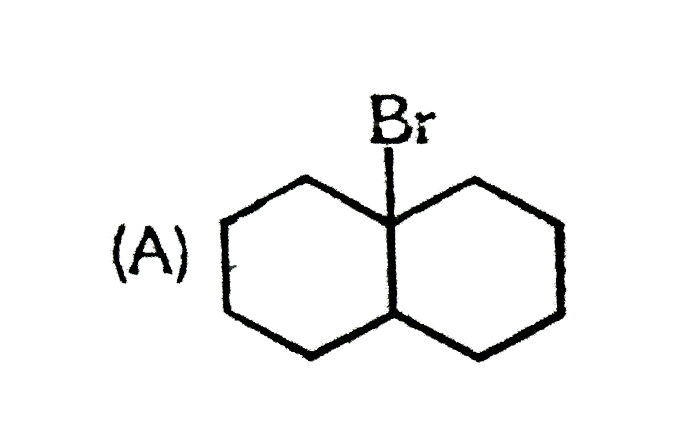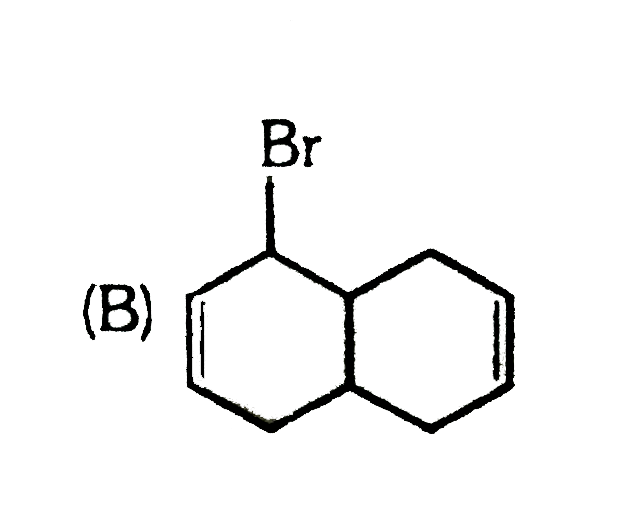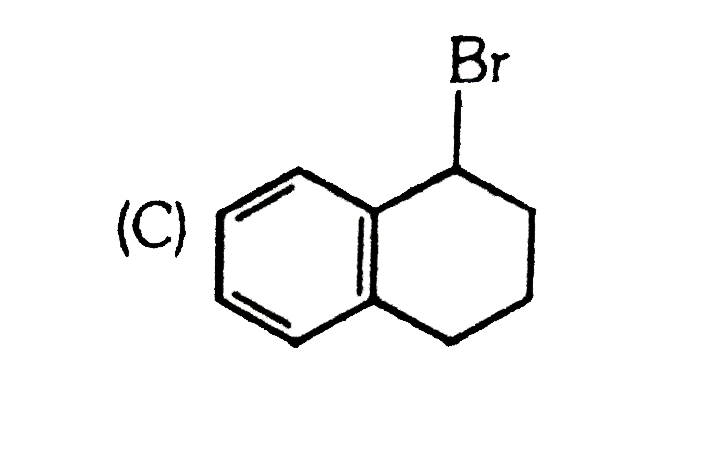An organic compound A has molecular formula C10H17Br and it is non-resolvable. A does not decolourize brown colour of bromine water solution. A on treatement with (CH3)2COK/(CH3)3COH yields B as majot product. B on treatment with H2/Pt yields (C10H16) which on treatment with CI2/hv yields three monochloro derivative. Also B on boiling with acidic permanganate solution yields C(C10H16O3)C. on heating with sodalime yields D(C9H16O).D on reducing with LiAIH4 followed yields C(C10H16O3).C on heating with sodalime yields D(C9H16O).D on reducing with LiAIH4 followed by heating product with concentrated H2SO4 yields E(C9H16) as major product. E on treatment with ozone followed by work-up with Zn−H2O yields 6-Ketononanal.
Compound A is:



none of these
The correct Answer is:A
To determine the structure of the organic compound A with the molecular formula C₁₀H₁₇Br, we will follow a systematic approach based on the information provided in the question.
1. Calculate the Degree of Unsaturation (DU):
- The formula for calculating the degree of unsaturation is:
DU=2C+2−H−X2
where C is the number of carbon atoms, H is the number of hydrogen atoms, and X is the number of halogen atoms.
- For compound A:
- C = 10
- H = 17
- X (Br) = 1
- Plugging in the values:
DU=2(10)+2−17−12=20+2−17−12=42=2
- This indicates that there are 2 degrees of unsaturation, which could be due to either 2 rings, 2 double bonds, or 1 triple bond.
2. Analyze the Reactivity with Bromine Water:
- The compound A does not decolorize bromine water, indicating that it does not contain any double bonds or triple bonds. Therefore, the degree of unsaturation must be attributed to rings.
3. Determine the Structure of Compound A:
- Since A is non-resolvable (optically inactive), it must have a symmetrical structure.
- Given that there are 2 degrees of unsaturation and the compound is non-resolvable, it is likely that A contains two identical rings that contribute to the non-optical activity.
4. Propose a Possible Structure:
- A reasonable structure for compound A is 1,2-dibromo-1,2-dihydroxycyclohexane or a similar bicyclic compound that fits the criteria of having two rings and being non-resolvable.
- The bromine atom can be attached to a carbon that is part of a symmetrical structure, ensuring that the compound remains optically inactive.
5. Final Structure of Compound A:
- Based on the analysis, the structure of compound A can be represented as follows:
- A is likely a bicyclic compound with two bromine atoms attached to the same carbon, making it achiral.
Conclusion:
The compound A is a bicyclic structure that is non-resolvable and does not react with bromine water. The exact structure can be confirmed through further analysis of the products formed in subsequent reactions.
- The formula for calculating the degree of unsaturation is:
DU=2C+2−H−X2
where C is the number of carbon atoms, H is the number of hydrogen atoms, and X is the number of halogen atoms.
- For compound A:
- C = 10
- H = 17
- X (Br) = 1
- Plugging in the values:
DU=2(10)+2−17−12=20+2−17−12=42=2
- This indicates that there are 2 degrees of unsaturation, which could be due to either 2 rings, 2 double bonds, or 1 triple bond.
- The compound A does not decolorize bromine water, indicating that it does not contain any double bonds or triple bonds. Therefore, the degree of unsaturation must be attributed to rings.
- Since A is non-resolvable (optically inactive), it must have a symmetrical structure.
- Given that there are 2 degrees of unsaturation and the compound is non-resolvable, it is likely that A contains two identical rings that contribute to the non-optical activity.
- A reasonable structure for compound A is 1,2-dibromo-1,2-dihydroxycyclohexane or a similar bicyclic compound that fits the criteria of having two rings and being non-resolvable.
- The bromine atom can be attached to a carbon that is part of a symmetrical structure, ensuring that the compound remains optically inactive.
- Based on the analysis, the structure of compound A can be represented as follows:
- A is likely a bicyclic compound with two bromine atoms attached to the same carbon, making it achiral.
The compound A is a bicyclic structure that is non-resolvable and does not react with bromine water. The exact structure can be confirmed through further analysis of the products formed in subsequent reactions.
Topper's Solved these Questions
- ALKYL AND ARYL HALIDEBOOK - ALLENCHAPTER - ALKYL AND ARYL HALIDEEXERCISE - EXERCISE-02
1 Videos
- ALKYL AND ARYL HALIDEBOOK - ALLENCHAPTER - ALKYL AND ARYL HALIDEEXERCISE - EXERCISE-04 [A]
1 Videos
- ALKYL AND ARYL HALIDEBOOK - ALLENCHAPTER - ALKYL AND ARYL HALIDEEXERCISE - EXERCISE-01
1 Videos
- ALKENE, ALKANE & ALKYNE BOOK - ALLENCHAPTER - ALKENE, ALKANE & ALKYNE EXERCISE - EXCERSISE-3
28 Videos
- Atomic StructureBOOK - ALLENCHAPTER - Atomic StructureEXERCISE - All Questions
62 Videos
Similar Questions
Knowledge Check
Which alkyne yields butanoic acid (CH3CH2CH2CO2H) as the only organic product on treatment with ozone followed by the hydrolysis ?
A1-ButyneB4-OctyneC1-PentyneD2-HexyneTreatment of a 2∘ OH with CrO3/H2SO4 yields an/a :
AaldehydeBcarboxylic acidCesterDketone
An alkyl bromide A has molecular formula C8H17Br and four different structures can be drawn for it, all optically active. A on refluxing with ethanolic KOH solution yields only one elirnination product B(C8H16) which it still enantiomeric. B on treatment with H2/Pt yields C(C8H18) which does not rotate the plane polarized light, B on ozonolysis followed by work-up with H2O2 yields D(C7H14O) as one product which it still resolvable. Deduce structures of A to D.
View SolutionAn organic compound (X) has molecular formula C7H6O2
and it does not effervesces with NaHCO3. X on treatment with
excess of HBr(aq) gives Y(C6H6O2) and CH2Br2. Y forms a
violet coloured solution with FeCl3. If X treated with Br2Fe,
how many different monobromination product would result?
View SolutionA hydrocarbon A(C10H12) has no chiral carbon. A gives a white precipitate with ammonical solution of silver nitrate. A on treatment with H2/pt gives B(C10H20). A on ozonolysis gives C(C8H12O4) as one product which on heating with soda lime gives D(C6H12). D on monochlorination with Cl2/hv gives C6H11Cl as sole isomer. Identify A to D.
View SolutionAmong the isomeric alkanes formula C5H12, identify the one that on photochemical chlorination yields only monochloro derivative.
View SolutionAn optically activ compound (A) has the molecular formula C6H10. The compound gives a ppt. When treated with Ag(NH3)2OH. On catalytic hydrogenation, A yields B(C6H14) which is only optically inactive identify the total number of αH in product formed by treatment of A with O3/H2O2 then LAH and then H⊕/Δ
View SolutionAn organic compound A’ with molecular formula C7H7NO reacts with Br2/aqKOH to give compound B’, which upon reaction with NaNO2&HCl at O∘C gives C’. Compound C’ on heating with CH3CH2OH gives a hydrocarbon D’. Compound B’ on further reaction with Br2 water gives white precipitate of compound E’. Identify the compound A, B, C, D&E, also justify your answer by giving relevant chemical equations.
View Solution
